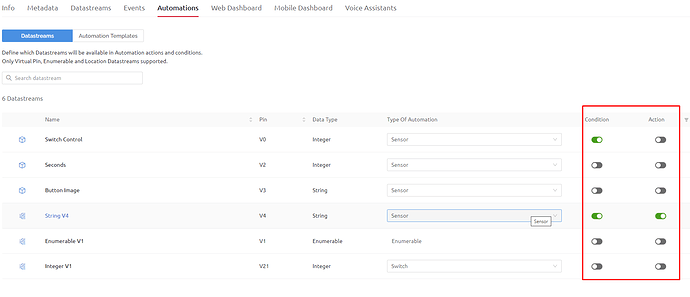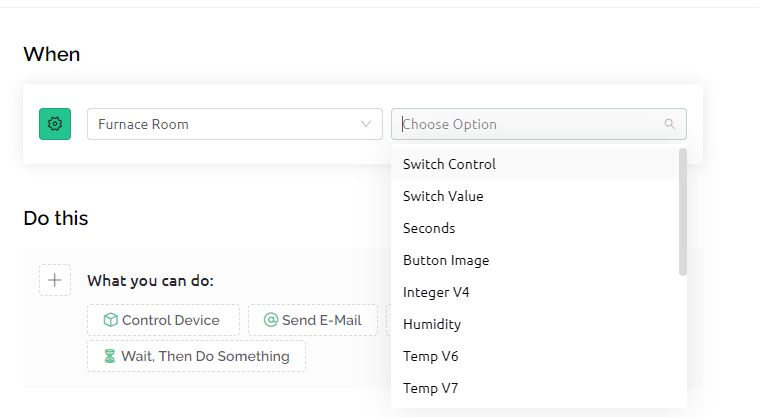I have an ESP8266 hooked up with basic humidity/temp, and an email notification. That all works fine. I just added an Argon with an HC-SR04 sensor that works fine otherwise, but when I assign it to my Blynk account and try to set up an automation, the Argon is showing the parameters from the ESP8266.
The thing is, there’s absolutely nowhere in my Argon code that references a DHT sensor, so I am looking at this as a Blynk issue.
Hi,
Please clarify are both devices created through one template?
Jeremy,
The devices created under one template have the same datastreams names.
Dmitriy from Blynk
blynk.io
So I created a new template, reassigned the device from the beginning and I am seeing the same thing. Logged out and back in to Blynk and the same issue.
Actually, now I can not assign an automation to the Argon.
Jeremy,
You probably have not added the option to use datastreams in automation in the template settings.
Template - edit - automation
Dmitriy from Blynk
blynk.io
Hmm… looking at that, but it still appears that something is wrong. While I have two devices connected and showing online, I can only set up automations for one of them (the ESP8266). The new data streams I made available aren’t showing because I cant even select the device they belong to (even though it is online).
The second device, an Argon, is no longer showing on this screen. Even though it is connected to Blynk and online.
Does the free account only allow me to set up automations with one device?
Jeremy,
The status of the device does not affect automation. The device may not be displayed in the Automation “Device State” only if it does not have datastreams with the enabled “Condition” option in the template settings. After adding, you need to update the page.
Dmitriy from Blynk
blynk.io
Thanks. I think I am finally getting the hang of the interface now. There’s a bit of a UX disconnect between the Datastreams and Automations tabs on the Template page vs the actual Automations page where you actually create the automations. It’s not 100% self-evident what the mental model is here, so I find myself having to click around a lot more than I think would be necessary. And that’s before any coding takes place on my project.
Maybe reading the excellent documentation on automations would have clarified some basic concepts for you and made the process easier.
Pete.
Perhaps Pete, but here’s the thing… users don’t read.  I’ve been doing tech in some form for 25+ years. You can have awesome documentation, but if the UX of the product/software is not well thought through, all that documentation doesn’t really help. In fact, all that documentation just reinforces the poor UX experience that is there in the first place, never getting to the root cause.
I’ve been doing tech in some form for 25+ years. You can have awesome documentation, but if the UX of the product/software is not well thought through, all that documentation doesn’t really help. In fact, all that documentation just reinforces the poor UX experience that is there in the first place, never getting to the root cause.
Instead, we should ask ourselves:
Why doesn’t X “click” with a user in the first place?
Why are we writing all this documentation to explain something that should be easier to execute?
How can we make it easier to execute?
Those questions will never be answered by telling users to “read the documentation”. Developers need to listen to users to find out how to make improvements. Then everyone wins.
So did you learn C++ programming by trial and error, without reading any documentation?
Blynk is a powerful and complex system, with web and mobile UIs that provide complimentary and sometimes overlapping functionality. Trying to ‘wing it’ without any reference to the documentation may work to a degree, but when you can’t figure out the finer details then it’s time to RTFM, whether you like it or not.
Pete.
1 Like
I’ve read more books and manuals than I care to count. And normally, I am a proponent of RTFM. But that misses the point I am making here…
Too many systems (web sites, services, products) are built without any consideration of how people will use them from a user perspective. This is an old problem, as explored in the works of Don Norman and countless others. I’ve used Particle.io, Adafruit.io, IFTTT and other platforms, and explored the previous Blynk.io functionality a few years back.
The new Blynk site is good, but it could be way better in terms of how it organizes various components. Before I came back to Blynk I read a ton of bad reviews about the UI, and thought “it can’t be that bad”, but the further I dive into it, I can see what they were referring too. If Blynk has a team of UX folks working on this, then cool. But if they are planning on solving this issue purely with documentation, that’s just not going to move things forward.



 I’ve been doing tech in some form for 25+ years. You can have awesome documentation, but if the UX of the product/software is not well thought through, all that documentation doesn’t really help. In fact, all that documentation just reinforces the poor UX experience that is there in the first place, never getting to the root cause.
I’ve been doing tech in some form for 25+ years. You can have awesome documentation, but if the UX of the product/software is not well thought through, all that documentation doesn’t really help. In fact, all that documentation just reinforces the poor UX experience that is there in the first place, never getting to the root cause.